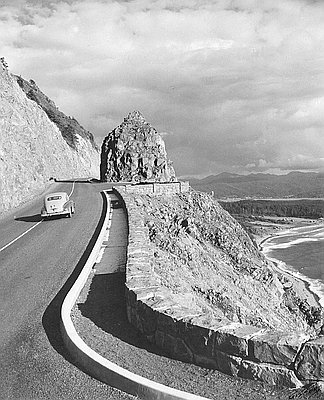The interstate highway system changed the face of America. Although Congress had been discussing the development of an interregional highway system since the 1930s, construction of this massive road system, the largest public works project in the nation’s history, did not begin in earnest until the passage of the 1956 Interstate Highway Act. This important piece of legislation would reshape the nation’s economic and cultural landscape for decades to come.
Interstate 5 was the centerpiece of Oregon’s interstate highway network. Completed in the fall of 1966 at a cost of $300 million, I-5 both bound the western portions of the state together and connected them with the larger West Coast, from Vancouver, British Columbia, to San Diego, California. The newsletter reproduced here shows several sections of the new highway and discusses the details of its construction.
In his dedication of I-5 in October 1966, Governor Mark Hatfield observed that “the freeway transformed the portion of the state it passed through into a single economic unit, tying cities and countryside into a progressive force.” Hatfield also noted that the highway had “aided immeasurably” the state’s budding tourist industry. “Truly,” he concluded, “this roadway has brought about a social, cultural and economic revolution which has not only benefited this generation but will continue to provide benefits for years to come.”
Although undoubtedly a major economic boon to the state, the interstate highway system has not been without costs. Traffic volume on I-5 has increased at a much greater rate than the state’s population, exacerbating the demand for oil imports and contributing significantly to urban sprawl and air quality problems. Some have also decried the loss of a localized sense of place, evident, for example, in the hundreds of national chain stores strung along I-5. John Steinbeck observed this change in the cultural landscape as early as 1960, remarking that “it’s now possible to cross the country, without seeing it.”
Further Reading:
Kirchmeier, Mark. “The I-5 Story.” Oregonian, April 9, 1989.
Lewis, Tom. Divided Highways: Building the Interstate Highways, Transforming American Life. New York, N.Y., 1997.
Written by Cain Allen, Oregon Historical Society, 2003.

